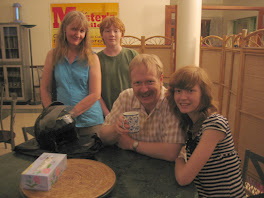 Back in April 2010, Shirley and I travelled to Snuol in Kratie Province, close to the border with Vietnam. Some time back, one of our OMF colleagues set up a library project there, and the main purpose of the trip was for Shirley to look over the libraries and see if, in discussion with our host, she could come up with some suggestions for improvement. It was also a good opportunity to visit with our OMF colleagues in the town - both the one who oversaw the library project and her husband, but also the other OMF family who lived in Snuol. It was also a chance to expand the number of up-country locations we had experienced for ourselves, always a good idea when the majority of one's time is spent in Phnom Penh. Lacking Shirley's professional library training and experience, my role in the visit was just as 'bodyguard' and photographer!
Back in April 2010, Shirley and I travelled to Snuol in Kratie Province, close to the border with Vietnam. Some time back, one of our OMF colleagues set up a library project there, and the main purpose of the trip was for Shirley to look over the libraries and see if, in discussion with our host, she could come up with some suggestions for improvement. It was also a good opportunity to visit with our OMF colleagues in the town - both the one who oversaw the library project and her husband, but also the other OMF family who lived in Snuol. It was also a chance to expand the number of up-country locations we had experienced for ourselves, always a good idea when the majority of one's time is spent in Phnom Penh. Lacking Shirley's professional library training and experience, my role in the visit was just as 'bodyguard' and photographer! The project consisted of eight middle school libraries and two commune libraries, and over our few days there, Shirley visited them all, sometimes travelling 40km by motorbike to reach the more outlying ones. In the end, I accompanied her to some, but not all. (Those trips seemed a long way to us, but our host, who overseas the library project, visits all of the libraries most weeks in order to encorage and guide the library staff.) OMF provides the funding for the librarians' salaries, and has also covered the costs of some of the books, with the set-up costs of the libraries and additional book donations coming from elsewhere. Such library work is important in Cambodia, where many books were deliberately destroyed during the Khmer Rouge period (1975-9), and even today there is limited literacy (77%, UNDP, 2010) and little recognition of the library profession or availability of training for librarians.
The project consisted of eight middle school libraries and two commune libraries, and over our few days there, Shirley visited them all, sometimes travelling 40km by motorbike to reach the more outlying ones. In the end, I accompanied her to some, but not all. (Those trips seemed a long way to us, but our host, who overseas the library project, visits all of the libraries most weeks in order to encorage and guide the library staff.) OMF provides the funding for the librarians' salaries, and has also covered the costs of some of the books, with the set-up costs of the libraries and additional book donations coming from elsewhere. Such library work is important in Cambodia, where many books were deliberately destroyed during the Khmer Rouge period (1975-9), and even today there is limited literacy (77%, UNDP, 2010) and little recognition of the library profession or availability of training for librarians.The photos above shows a slogan from one of the middle school liraries, proudly displayed on the classroom wall: "Read a Lot to Understand a Lot", and some children at a commune library, demonstrating that libraries can be fun. The photos below show Shirley and our host talking to one of the OMF librarians, and an outside view of another commune library.




